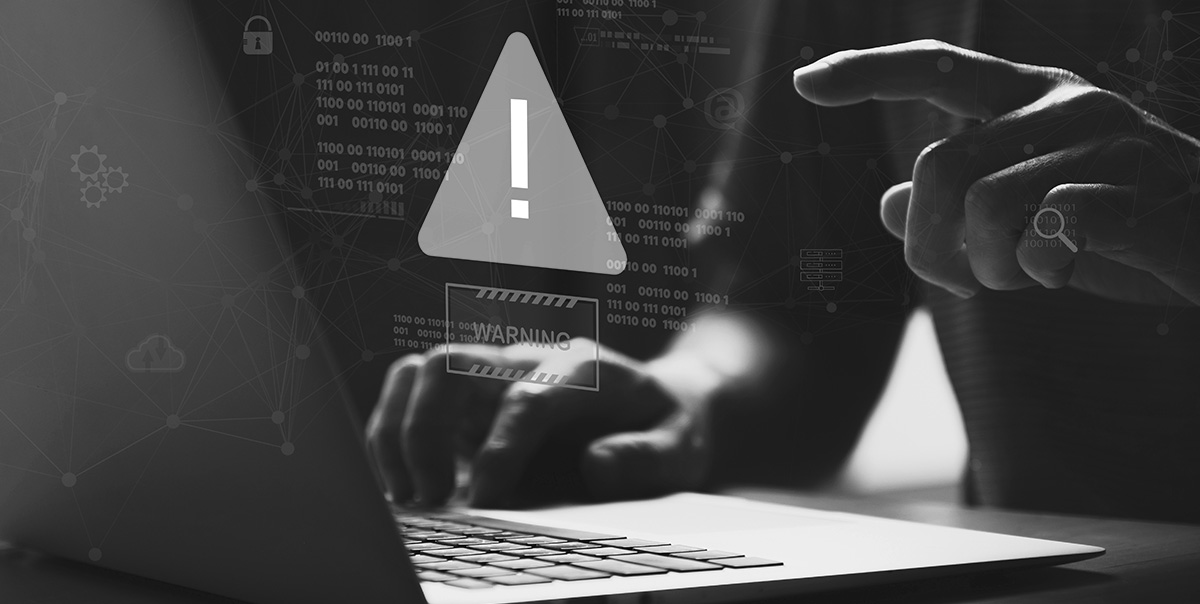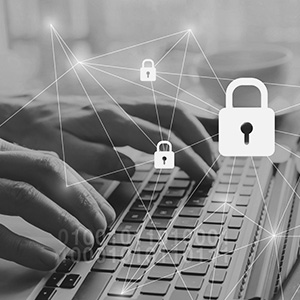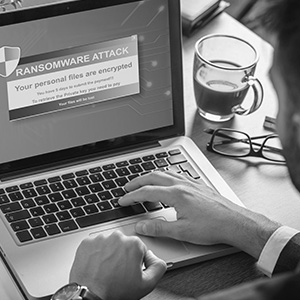What Is Threat Detection?
How can you protect yourself when you don’t know you’re being attacked? Threat detection tools work to monitor your network for malicious activity, alerting your security team the moment a risk is uncovered. These solutions help prioritize risk, providing vital information to enable a rapid response which can be the difference between maintaining security across the enterprise and a devastating breach that may cripple your organization.
Both IT environments and their attackers have grown far too sophisticated for a single surefire solution to exist. Security strategies must be as multi-faceted as the infrastructures they protect. That’s why threat detection can be used as a preventative, proactive measure against malware attacks, as well as a reactive method to advanced persistent threats infecting a system. Threat detection is also a critical part of any vulnerability management program, which can help you be ready for any type of security threat or disruption.

What Are Different Types of Threats?
A cyber threat is any entity that creates the potential to exploit a security weakness. Typically, most threats consist of some type of malware, which is the broad term that covers every type of software that is created to disable or damage computer systems.
Different types of malware include:
Virus
Just like its biological namesake, a computer virus infects a computer system by replicating itself without user permission, inserting its own code into preexisting programs. In order to spread to other systems, the virus must be attached to a file or executable program, and only infects a system when opened. This typically causes various amounts of damage, from impeding work through annoying popups to causing a complete system crash.
Just like its biological namesake, a computer virus infects a computer system by replicating itself without user permission, inserting its own code into preexisting programs. In order to spread to other systems, the virus must be attached to a file or executable program, and only infects a system when opened. This typically causes various amounts of damage, from impeding work through annoying popups to causing a complete system crash.
Worm
Similar to a virus, a worm can replicate itself on a computer system and cause varying levels of damage. Unlike a virus, a worm is a standalone program, and does not need to be attached to a file and opened to spread. A worm exploits vulnerabilities in a system, and uses network connections to infect other systems with similar weaknesses.
Similar to a virus, a worm can replicate itself on a computer system and cause varying levels of damage. Unlike a virus, a worm is a standalone program, and does not need to be attached to a file and opened to spread. A worm exploits vulnerabilities in a system, and uses network connections to infect other systems with similar weaknesses.
Ransomware
Ransomware is software that holds data hostage, with the threat to publish it or destroy it unless a ransom is paid. Unfortunately, even if organizations pay, they’re not guaranteed to get their data back, and giving into demands only encourages a repeat attack. Additionally, one of the greatest threats of ransomware is its power to be used as a decoy. Attackers use ransomware as a tool to get IT and security teams chasing potential infections, allowing them to infiltrate the network and get what they are truly seeking.
Ransomware is software that holds data hostage, with the threat to publish it or destroy it unless a ransom is paid. Unfortunately, even if organizations pay, they’re not guaranteed to get their data back, and giving into demands only encourages a repeat attack. Additionally, one of the greatest threats of ransomware is its power to be used as a decoy. Attackers use ransomware as a tool to get IT and security teams chasing potential infections, allowing them to infiltrate the network and get what they are truly seeking.
Cryptomining Malware
Cryptomining malware infects a computer system like a parasite, sucking the processing power to use it to mine for cryptocurrency. This allows cryptominers to mine more transactions faster, turning a way to make a couple extra bucks into a major payout. Unfortunately, it leaves the victims with painfully slow systems, or ones that end up crashing altogether. When it comes to cryptojacking, the more power, the better. Consequently, organizations with multiple computers and servers make perfect targets.
Cryptomining malware infects a computer system like a parasite, sucking the processing power to use it to mine for cryptocurrency. This allows cryptominers to mine more transactions faster, turning a way to make a couple extra bucks into a major payout. Unfortunately, it leaves the victims with painfully slow systems, or ones that end up crashing altogether. When it comes to cryptojacking, the more power, the better. Consequently, organizations with multiple computers and servers make perfect targets.
DOS & DDOS Attacks
A denial-of-service (DoS) attack interrupts normal operation of system or device (typically network servers), forcing it to deny access and or cause downtime. This is usually accomplished by bombarding the target with traffic so no regular traffic can get through. This often results in a slow down of service or a complete crash. In a DoS attack, the flood of traffic comes from a single source, but a distributed-denial-of-service attack (DDoS) is at a much larger scale, since the influx of traffic comes from multiple sources. This makes recovery significantly more challenging, since the attack is multi-faceted, the origin is difficult to pinpoint, and can result in much longer periods of downtime.
A denial-of-service (DoS) attack interrupts normal operation of system or device (typically network servers), forcing it to deny access and or cause downtime. This is usually accomplished by bombarding the target with traffic so no regular traffic can get through. This often results in a slow down of service or a complete crash. In a DoS attack, the flood of traffic comes from a single source, but a distributed-denial-of-service attack (DDoS) is at a much larger scale, since the influx of traffic comes from multiple sources. This makes recovery significantly more challenging, since the attack is multi-faceted, the origin is difficult to pinpoint, and can result in much longer periods of downtime.
What Are the Benefits of Threat Detection?
Prevent or Thwart Attacks
Threat detection tools can block or prevent the spread of both known viruses as well as unidentified viruses by detecting features and behaviors that distinguish malware.
Avoid Costly Downtime
Viruses and malware can damage your bottom line as well as your system. Preventing attacks can spare a business from having to suffer downtime, not to mention the major disruption a data breach.
Protect Business-Critical Data
Your business can’t tolerate any downtime, much less the major disruption a data breach or ransomware attack can cause. Without threat detection solutions, data can be stolen or destroyed.
Meet Compliance Requirements
Whether your organization must demonstrate compliance with PCI DSS, HIPAA, GLBA, or other regulations, threat detection can be critical to meeting the latest requirements. Many of these laws contain specific wording about implementing safeguards that reduce risk and maintain data integrity.
What Type of Threat Detection Do I Need?

The most foundational type of threat detection is antivirus. Antivirus solutions focus on detecting and blocking malware from entering your environment. It's incredibly uncommon for workstations PCs to not have an antivirus software of some kind installed. However, workstation PCs are not the only endpoint in need of protection. Malware can just as easily target your servers—both on-premises or in the cloud, as they are the key storage areas data attackers and threat actors are eager to exploit. Endpoint, native antivirus software is needed to provide malware protection to servers that connect to enterprise networks.
If server-side antivirus is used, it may still be getting inadequate protection. Operating systems—like Linux, AIX, or IBM i—require a native solution to ensure each platform is uniquely protected from malware. Attempting to scan your server with a Windows solution is not only unreliable, it can also add additional security concerns. Pairing workstation antivirus with a native solution for your servers builds the most robust malware defense by providing multiple layers of security.

Antivirus has become so fundamental that compliance regulations for most industries require it. Once you have met this requirement with both workstation and server side antivirus solutions, you can look at your security holistically. What other solutions do you currently have in place? What problems are they solving? What security issues still need to be addressed? Which ones are the highest priority for your organization? This will help you to determine what solution is the best suited for your most pressing need. One of the most dangerous risks that is rapidly becoming more common are advanced persistent threats, making advanced threat detection solutions increasingly important.
What Are Advanced Persistent Threats?
Advanced Persistent Threats (APTs) are a cybercrime category directed at business and political targets. APTs require a high degree of stealth over a prolonged duration of operation in order to be successful. The attack objectives typically extend beyond immediate financial gain, and compromised systems continue to be of service even after key systems have been breached and initial goals reached.
Criminal operators behind the threat utilize the full spectrum of computer intrusion technologies and techniques. For example, unique attack vectors are often exploited, since antivirus solutions specific to IoT devices has not yet been created. This makes everything—security cameras, video conference units, HVAC systems, MRIs, CT machines, ATMs, SCADA systems, and countless other devices—a perfect doorway for threat actors looking for a way into an organization’s infrastructure.
While individual attack components may consist of simple methods, like a piece of malware purchased on the dark web, their operators can typically access and develop more advanced tools as required. Threat actors combine multiple attack methodologies and tools in order to reach and compromise their target.
Additionally, these operators give priority to a specific task, rather than opportunistically seeking immediate financial gain. The attack is conducted through continuous monitoring and interaction in order to achieve the defined objectives. It does not mean a barrage of constant attacks and malware updates. In fact, a “low-and-slow” approach is usually more successful.
What Is Advanced Threat Detection?
Advanced threat detection tools find advanced malware, APTs, or signs of APTs, and alert security teams of their presence. Advanced threat detection focuses less on prevention, and more on detection.
The goal of these solutions is to swiftly detect infections before the attack cycle is complete, so that security analysts can both eliminate the threat and minimize damage, enabling rapid recovery and remediation. Discovering threats as soon as possible is the best way to minimize damage.
Instead of monitoring the network, advanced threat detection solutions monitor the traffic, looking for and confirming malicious activity, ensuring that action can be taken the moment it is identified. These solutions allow your environment to be monitored without disruption.


Ryuk ransomware serves as an ideal example of the power of advanced threat detection. It begins as a phishing email or a drive-by download triggered by visiting a website or clicking on a popup. The threat actors establish persistent access to the network, and can use techniques like exploiting vulnerable machines, installing keyloggers, or stealing credentials to move around the infiltrated network. Threat actors look for information to steal, then gather and exfiltrate it. They install Ryuk on each system before encrypting the machines and ransoming their victims. By finding evidence of and flagging this persistent access, advanced threat detection tools can alert an organization that an active attack is already underway. Early detection and remediation can minimize exfiltration and prevent Ryuk from being placed and triggered, thwarting the ransomware element completely.
What Are the Benefits of Advanced Threat Detection?
- Shorten the dwell time of infections: By constantly monitoring network traffic, advanced threat detection tools can send out actionable alerts to security teams that will enable them to investigate and eliminated the threat.
- Reduce risk of damage: The longer an infection lives in a network, the more damage it can do. Swiftly detecting a threat can ensure that there is minimal harm.
- Protection of every endpoint: By monitoring IoT devices, security teams can detect threats on vulnerable attack vectors before a threat actor can move deeper into the infrastructure.
- Improve efficiency: Automation of threat detection allows organizations to do more with less and ensures that security analysts are able to focus more on threat removal.
Threat Detection Solutions from Core Security
Powertech Antivirus
Native virus protection software for IBM systems (Linux, AIX, and IBM i).
Learn More >
Event Manager
Comprehensive Security and Event Management (SIEM) solution that provides real-time threat detection and prioritization.

